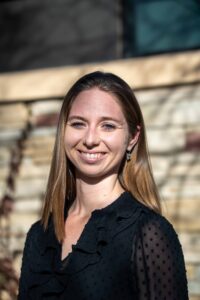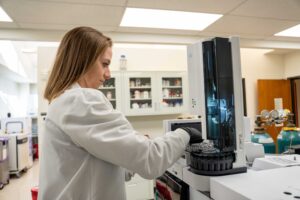
Maureen Walsh, a Ph.D. student in the Human Bioenergetics Program in the Colorado State University Department of Health and Exercise Science, received the 2023-24 Dean’s Fellowship to pursue her research on how a plant-based compound could improve hallmarks of skeletal muscle and brain aging to keep people healthy longer as they age. Read on to learn more about Walsh’s personal journey pursuing degrees in exercise science and discovering her interest in the research process.

Tell us about where you are from and your undergraduate experience.
Originally from Hermitage, Pennsylvania, I grew up roasting and packing coffee beans at my family’s small business. However, the importance of optimal health has always fascinated me. I was a ballerina for over a decade where developing an impeccable human machine was the goal. Outside of the ballet studio, I had a strong interest in my science classes. Therefore, I chose to pursue an undergraduate degree in exercise science from Slippery Rock University in Pennsylvania. Collectively, my undergraduate experience exceeded my expectations. Beginning my freshman year, I became involved in research which was a springboard for pursuing graduate-level degrees in the field of exercise science.
What inspired you to continue to graduate school at CSU and to apply for the Dean’s Fellowship?
As an undergraduate, my intellectual curiosity led me to attempt to understand how certain hemodynamic variables changed with exercise and health status. Through my undergraduate coursework, I realized I wanted to understand how cellular adaptations can help prevent or diminish the burden of age-related chronic diseases. Therefore, I decided to pursue health-related master’s and doctoral degrees at CSU where I work in the Translational Research on Aging and Chronic Disease Laboratory directed by Dr. Karyn Hamilton. Intellectual curiosity has always been my philosophy where I am pursuing the goal of identifying strategies to improve healthy aging. I decided to apply for the Dean’s Fellowship to obtain funding to examine how a plant-based compound could improve hallmarks of skeletal muscle and brain aging. Additionally, I think it is critical for researchers to be able to convey their science to those outside their discipline. Given the diversity of interests in the College of Health and Human Sciences I also believe that applying for the Dean’s Fellowship challenged me to write to a broader audience and hopefully make a larger impact.
Describe your research and its significance.

We have an increasing population of older adults. Modern medicine has helped extend the human lifespan but not the healthspan. The healthspan is the period an individual is free from age-related chronic diseases. While many older adults are living longer, they are burdened by the development of age-related chronic diseases. Medicine currently treats the symptoms of diseases individually. However, these diseases have common underlying and interconnected cellular drivers that are present during aging. My Dean’s Fellowship examines how the cellular drivers of brain and skeletal muscle aging in a guinea pig model mirrors human aging. By first uncovering the details of brain and skeletal muscle aging, we can begin to test potential treatments to limit the drivers of aging. Because the drivers are connected, slowing one or two drivers will in turn slow others. Specifically, I study a plant-based compound known to positively affect multiple cellular aging processes in the brains and skeletal muscles of guinea pigs. Thus far we have observed positive effects in skeletal muscle health and mobility, two critical metrics of healthy aging.
What do you hope will be the long-term impacts of your research?
Translational science is often phrased as lab bench to patient bedside with an average time of 17 years. Therefore, my long-term goal is to try to compress this gap. My short-term goal is to determine if this plant-based compound demonstrates resounding positive health effects in preclinical animal models. If that is the case, then I hope to translate these findings to human clinical trials. The plant-based compound, PB125, is currently commercially available, further assisting in rapid translation to help older adults.
How have your mentors helped to guide you throughout your career so far?
I was once told it takes a village to mentor a student. Throughout my undergraduate and graduate training, I have been fortunate to be mentored by several amazing individuals. My undergraduate mentor, Dr. Brock Jensen, was instrumental in sparking my passion for research. He also helped me determine the best graduate program which has allowed me to thrive as a life-long learner and person.
At CSU my mentoring team vastly expanded to include Drs. Hamilton, Kelly Santangelo, Julie Moreno, Tom LaRocca, and Brett Fling, all members of my doctoral committee. Individually, they have challenged my intellectual thought process but collectively they have allowed me to grow as a thinker and person. I am grateful for the frequent conversations that I have with each of these outstanding scientists and individuals beyond the regularly scheduled committee meetings. However, the withstanding rock of a mentor has been Dr. Karyn Hamilton who has pushed me to embrace new opportunities, develop new skills, and share the highs and lows of the ultra-marathon race that is a Ph.D.
I have also sought mentorship through a variety of avenues to help me narrow my career path. Specifically, Kimber Finan has been instrumental in sparking my interest in teaching at CSU and through countless conversations has helped me navigate my next steps. Additionally, she was my mentor for my doctoral supervised college teaching where I gained skills and experience teaching undergraduate learners. Collectively, there have been amazing people along the way who continue to inspire me to do my best and be my best.
What are your future plans after earning your Ph.D.?
After obtaining my Ph.D. in the spring, I will join my alma mater, Slippery Rock University, where I have accepted a tenure-track assistant professor position. I plan to continue a small line of research while returning to my roots of understanding the physiological effects of exercise, co-treatment with plant-based compounds, and the impacts on health. Additionally, I am very excited to have a strong presence in the classroom teaching students about the physiological responses to exercise. Slippery Rock University was where my passion for research developed because of faculty members who patiently helped me, and I now plan to help inspire the next generation of undergraduate learners. I do not think it gets much better than this!
The Department of Health and Exercise Science is a part of CSU’s College of Health and Human Sciences.